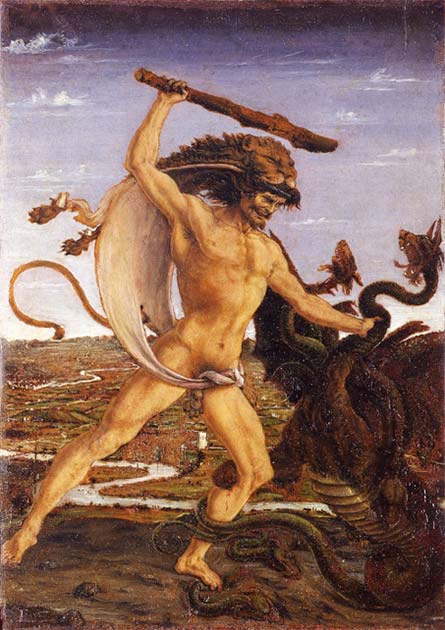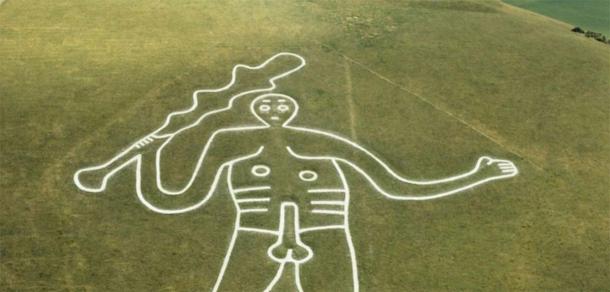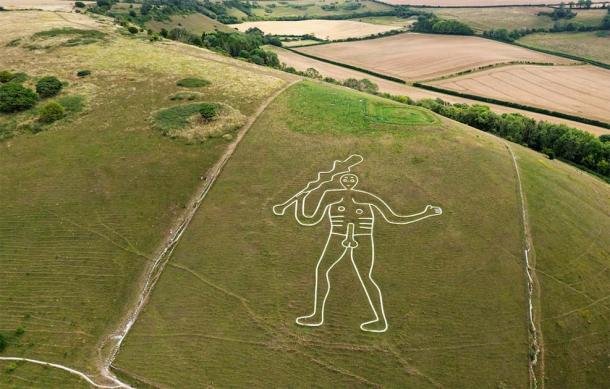
Cerne Abbas Chalk Figure Now Identified As the Greek Hero Hercules
Researchers have been speculating for centuries about the meaning and origin of a gigantic 180-foot (55-meter) human figure carved into a chalky hillside near the village of Cerne Abbas in Dorset, England. While many explanations have been offered purporting to explain who this man really is, a new study published in the medieval history journal Speculum asserts that the mystery has been solved. The answer to this timeworn question appears to be that the individual carved into the hillside is none other than Hercules, the Greek behemoth who was the world’s first superhero.

Hercules and the Hydra by Antonio del Pollaiuolo. (Public domain)
Decades of Speculation on Cerne Abbas Hercules
The distinctive white outline of Cerne Abbas figure reveals a powerful man wielding a heavy club in his right hand, with his left arm extended and his phallus fully erect. Since the remarkable chalk figure known as the Cerne Abbas giant was first discovered, researchers and historians have been debating its true identity.
Some suggested it portrayed an ancient British sky god named Helith, who was supposedly worshipped in Britain during prehistoric times. Others believed the figure was carved much more recently, and that it was actually a tribute to the legendary Oliver Cromwell. Another theory claimed that the figure portrayed Saint Eadwold, a pious ninth-century prince who lived modestly as a hermit in the region and was chosen as the patron saint of Cerne sometime after his death.
- ‘Missing Detail’ From the Cerne Abbas Giant Story Revealed
- Tests Reveal True Age of Naked Cerne Abbas Giant
In the new study, historians Tom Morcom from the University of Oslo and Helen Gittos from Oxford University argue that none of these theories fits the known facts. The only explanation that makes sense, they assert, is that the huge naked man carved in chalk is actually the famous Greek hero Hercules, whose courageous deeds and immense strength formed the historical template for modern superheroes like Superman and Captain Marvel.
“We've tried to put together the most convincing and coherent narrative,” Dr. Morcom said in The Daily Mail. “It's how it all fits together and how the giant could have been most likely understood.”

The Cerne Abbas Giant. (University of Oxford)
Making the Case for the Cerne Abbas Hercules
A key factor that allowed the researchers to make this determination was a 2021 study that proved the image of the giant man was cut into the hillside in Dorset between the years 700 and 1100 AD. This discovery cleared up centuries of confusion about when exactly the imposing chalk figure had been created.
The impact of this finding has been immense. It has eliminated the possibility that it could have been carved as a tribute to Oliver Cromwell, the military conqueror who served as England’s Lord Protector in the 17th century. It also negates the theory that the figure was an ancient sky god carved into the rock thousands of years ago. In fact, the researchers claim that the god Helith never actually existed in any conceptual form, and the belief that he did is based on a 13th century mistranslation of the Latin word for Elijah, a Hebrew prophet who was written about in the Old Testament.
As for the suggestion that the chalk figure might be Saint Eadwold, Professors Morcom and Gittos dismiss this idea as an 11th century invention of monks living at an abbey in Cerne. The monks likely laid claim to the giant as a way to gain access to Saint Eadwold’s relics, and to gain greater status for their abbey.
“Having a large, very obviously naked, pagan figure on your doorstep was an inconvenient fact for the monks and they engaged in a piece of intellectual interpretation, associating him with their patron saint, Eadwold,” Dr. Morcom told the BBC.
According to the researchers, it is possible to find references to Hercules in British literary sources from the medieval period. In one case, the people who wrote about Hercules either came from or had links to the village of Cerne Abbas.
And there is also a physical resemblance to how Hercules was portrayed elsewhere. The giant’s club, for example, matches the one the Greek hero had frequently been shown holding in carved or painted images from ancient times. The historians also noted that there are British depictions of Hercules that show him naked and with an erect phallus, and with a posture that is similar or identical to that of the Cerne Abbas giant.
They concluded that the carving may have originally included Hercules’s traditional mantle or cloak draped over his arm as well, which would have been overgrown with vegetation and lost from sight over time. “The position of his arm is such that it fits so well,” Dr. Gittos stated. “It seems quite likely.”

The figure was carved into the hillside near Cerne Abbas. Experts believe it was an ancient representation of Hercules. (David Matthew Lyons / Adobe Stock)
The Cerne Abbas Hercules: Giant Inspiration in Times of Trouble
The Cerne Abbas giant was carved into the hillside near Cerne Abbas at a spot where several important roads converged. Also, it was near multiple locations that had been invaded by Vikings during their ravages of Britain that started in the late eighth century AD.
Consequently, this location in Dorset may have functioned as a gathering site for Anglo-Saxon armies being prepared for deployment. This would make the huge and formidable Hercules carving a military symbol, one meant to inspire Anglo-Saxon soldiers into heroic action.
- Defacing of Cerne Abbas Giant by Amazon Provokes National Trust Wrath
- Research Shows Cerne Abbas Giant Chalk Figure Is NOT Ancient
There is textual evidence from medieval times that supports this theory. “This land was owned by the West Saxon royal family in the 9th Century and the 10th century, and we have descriptions of that land,” Dr. Gittos explained. “They describe that there was a herepath—an army road—that led on to Giant Hill and this hillside looks like a special kind of meeting place that we now recognize in the Anglo- Saxon landscape.”
If the theory that this figure is Hercules is correct, it adds a new dimension to interpretations of the work, Dr. Gittos added. “What's wonderful is that the story we have found is so much more interesting than it being a mystery. It tells us so much more about this place and these people and that, for me, is really exciting.”
It remains to be seen how widely accepted this new theory about the origin and meaning of the Cerne Abbas giant will be. Those who've invested time and energy pursuing other explanations may not be ready to give up just yet. This isn’t the end of attempts to understand the meaning of the Cerne Abbas giant, since conclusive proof that the giant is actually Hercules is lacking, as Drs. Morcom and Gittos concede.
Top image: Drone image of the Cerne Abbas Giant, a.k.a. the Cerne Abbas Hercules. Source: Roberto / Adobe Stock
By Nathan Falde















